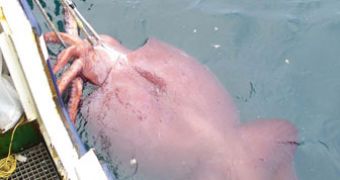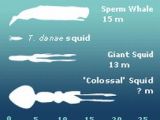This is one of the most sounding victories of cryptozoology. For long, the giant squids were thought to be just legendary creatures, the kraken of the northern sagas. Later on, the individuals washed ashore helped change this view. In recent years, fishermen even began to capture individuals. The one caught in February 2007 is the largest of all them. A New Zealand fishing crew accidentally captured the animal off the coast of Antarctica, while fishing Patagonian toothfish (Chilean sea bass). Now, a New Zealand team is thawing the corpse of the huge squid as part of a study attempting to analyze the anatomy of the mythical animals.
In 2006, a Japanese team had managed to catch a few glimpses of such an animal in its natural deep ocean habitat, but the examination that started today will explain many issues about the 1,089-pound (490 kg), 26-ft (8.6 m) long colossal squid. The thawing and examination are being broadcast live on the Internet.
"The squid, which was caught accidentally by fishermen last year, was removed from its freezer Monday and put into a tank filled with saline solution. Ice was added to the tank Tuesday to slow the thawing process so the outer flesh wouldn't rot. After it is thawed, scientists will examine the squid's anatomical features, remove the stomach, beak and other mouth parts, take tissue samples for DNA analysis and determine its sex," said Carol Diebel, director of natural environment at New Zealand's national museum, Te Papa Tongarewa.
"If we got ourselves a male it will be the first reported (scientific) description of the male of the species. The squid is believed to be the largest specimen of the rare deep-water species Mesonychoteuthis hamiltoni, or colossal squid, ever caught," Steve O'Shea, a squid expert at Auckland's University of Technology and involved in this research, told National Radio.
Colossal squid is the largest invertebrate ever and the most mysterious of the huge squids, growing up to be 46 ft (15.3 m) long. It usually roams to depths of 6,500 ft (2,160 m) into the ocean and are believed to be aggressive predators. The species was first detected in 1925, in the form of two tentacles spat out by a sperm whale. Calamari rings made of this animal would be the size of tractor, but the meat has an ammonia-like scent (resembling urine).
The squid had been lured by a hooked toothfish to the nets of the fishermen, who realized the importance of their capture and preserved it through freezing. It was then donated to the national museum, Te Papa Tongarewa. The first colossal squid ever captured was a 660 pound (300 kg) female squid, caught in 2003.
Colossal squid are found in Antarctic waters and are not related to giant squid found round the coast of New Zealand. Still, the most known of the huge squids is the giant squid (Architeuthis dux), which can reach 39 ft (13 m) in length, but is much less massive. This is the main object of the observations on huge squids and on the battles with sperm whales as it populates temperate waters around the world.

 14 DAY TRIAL //
14 DAY TRIAL // 
